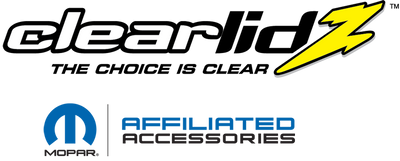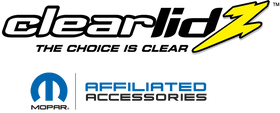ClearLidz vs. Other Jeep Tops: Which Roof Is Right for Your Wrangler?
 TL;DR: If you’re deciding between factory hardtop panels, soft tops, or clear panel alternatives, start with the basics - noise, heat, visibility, and daily use. This comparison highlights when a panoramic ClearLidz roof wins on clarity and convenience, and where other options still make sense. For common panel problems and replacement paths, see our Freedom Panels guide.
TL;DR: If you’re deciding between factory hardtop panels, soft tops, or clear panel alternatives, start with the basics - noise, heat, visibility, and daily use. This comparison highlights when a panoramic ClearLidz roof wins on clarity and convenience, and where other options still make sense. For common panel problems and replacement paths, see our Freedom Panels guide.
Your decision framework (noise, heat, visibility, hassle)
Use these four questions to cut through the clutter:
-
How quiet do you need highway cruising to be?
-
How hot or dim does your cabin feel today?
-
How often do you remove or store panels?
-
What’s the total cost - money, time, and cargo space?
Keep those answers in mind as you compare.
ClearLidz Panoramic Jeep roof (what it is)
A rigid, panoramic first-row roof designed to live on the Jeep year-round. You get cabin-brightening clarity and visibility without the remove-bag-store cycle of two-piece panels.
Strengths
-
Bright, open-air feel at all times
-
Fewer leak/noise vectors than two-piece seams
-
No storage burden; keep cargo space free
Trade-offs
-
Not a full-tilt “convertible” experience like a full soft top
-
Accessory clearance should be measured (light bars, racks)
Best for: Daily drivers and trailers who want visibility, the open air feel and light without juggling panels and while being protected from the elements.

OEM Hardtop Freedom Panels
Two removable panels over the driver/passenger with factory fit/finish.
Strengths
-
Factory look and resale familiarity
-
Good security and weather performance when new and well-sealed
Trade-offs
-
Seams and latches can introduce drips/whistle as seals age
-
Requires storage bags and cargo space
Best for: Owners who rarely remove panels or prioritize a stock appearance.
Full soft tops (standard and premium variants)
Fabric systems with bows or spring mechanisms; some include easy-flip sections.
Strengths
-
Max open-air feel; quick flip-back sections on many models
-
Lighter than hard tops for seasonal swaps
Trade-offs
-
Typically louder at highway speeds
-
Fabric care, window scratching, and security limits
-
Still requires swapping or stowing pieces seasonally
Best for: Drivers who prioritize top-down days and don’t mind added noise or upkeep.
Aftermarket solid replacement panels
One-piece or two-piece hard panels from third parties.
Strengths
-
Can mimic factory look at lower cost
-
Some add insulation or different textures
Trade-offs
-
Still involve removal and storage
-
Quality and seal performance vary by brand
Best for: Budget-minded owners staying with a solid, opaque look.
Clear Panels and Sunshades
From transparent panel replacements to mesh shades under stock panels.
Strengths
-
More light than opaque panels (clear) or filtered light with airflow (mesh)
-
Some budget-friendly
Trade-offs
-
Clear replacements may still need removal and careful storage
-
Mesh doesn’t fix cabin dimness at night or rain protection
- Does not offer much protection from the elements such as rain and snow
Best for: Occasional use and fair-weather drivers who want sunlight at low cost.
Head-to-head: what you’ll notice on day one
Noise:
-
Quietest: well-sealed hard surfaces with continuous seals. ClearLidz removes the center seam that often whistles.
-
Loudest: many soft tops at highway speeds.
Heat & light:
-
Brightest cabin: ClearLidz (panoramic clarity along with 99% UV protection).
-
Darkest/heat-trapping: opaque hard panels, especially in sun.
Hassle factor:
-
Lowest: install once and drive. ClearLidz eliminates panel removal and storage.
-
Highest: frequent hard-panel swaps and bagging.
Cargo space:
-
Best preserved: ClearLidz (no panels riding in the rear).
-
Most used: stowing hard panels/bags.
Cost of ownership (money, time, and wear)
-
Upfront: OEM hard panels often cost more than you expect; used take-offs require careful inspection of seals and latch pockets.
-
Ongoing: Soft tops can need fabric/window replacements; two-piece systems risk scuffs and seal wear from repeated handling.
-
Hidden: Scratches from storage, time spent mounting/dismounting, and space lost to panel bags.
Quick pick scenarios
-
Daily commuter who wants a bright, airy cabin year-round: ClearLidz.
-
Weekend cruiser who lives for doors-off, top-down days: Soft top or hybrid system.
-
Show-build purist who needs factory lines: OEM hardtop panels.
-
Budget refresh for worn panels: Aftermarket solids or careful used take-offs.
FAQs
Will a panoramic roof make the Jeep hotter?
ClearLidz uses coatings that block UV and a meaningful portion of IR to help manage heat while keeping the cabin bright.
Is wind noise better or worse than stock panels?
Removing the center seam reduces common whistle points; a clean, continuous seal and proper install are key.
Can I still run a light bar or rack?
Many first-row bars and low-profile racks work, but measure bracket height and clearance before installing.
What about winter and car washes?
Designed for year-round use. Any carwash or gentle hand washes and keep seals free of grit and salt.
Can I install it myself?
Most mechanically inclined owners can handle install with basic tools; verify accessory clearances first. To remove completely - No tools are needed, can be installed in 15 minutes or less.
Ready for daily clarity without the panel juggle?
If you want open-sky visibility, a quieter seal path, and zero storage hassle, shop our premium selection of clear panels today.





